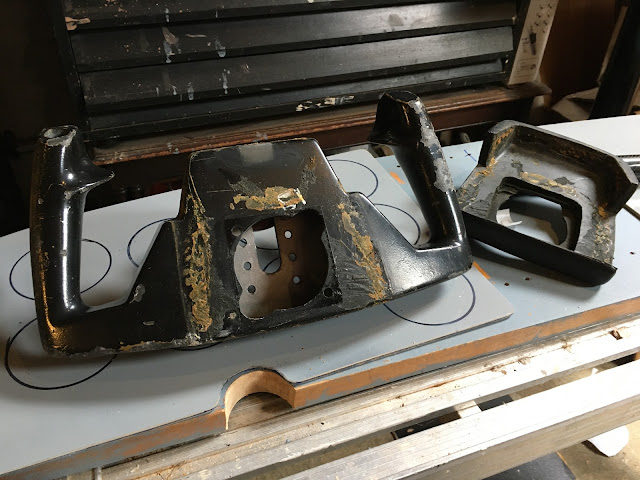Cessna 337 Yokes — Cold and Dark
The genuine Cessna 337 control-wheels (yokes*) arrived swiftly and were taken upstairs to my shop for their grand unboxing.
I like unboxing and who does not?
There's always a certain nervy, excitable tension and then the shock when an object previously only seen in pictures is suddenly very real and somehow always somewhat different than imagined.
Bigger, smaller, heavier, lighter, uglier, prettier, more substantial, a waste of good money even...
This pair of old warriors with their chipped paint and modifications were not at all as expected. They were really surprising ~
Cold and dark — and very heavy. They were so much weightier than expected, that for a moment I thought they were made of steel. A run around with a magnet denied this and confirmed the only parts made of steel were the shafts.
Simple dimensions are 11 inches width x 6 inches height.
These castings are heavy-duty. Of aluminium, they were cast in one piece with an average wall thickness of about a quarter-inch, excepting the face, which is a little thinner. The pilot's wheel has a socket on top of the left hand grip for a push-to-talk switch and an exit hole at bottom for its cable.
The hand grips were hollow cast, though I say this with some uncertainty, because although an audible tap test with the shaft of a screwdriver seems to confirm this, the only holes for cables are those on the pilot's left hand grip.
The weight of the unmodified wheel is 2lb 13oz 8 drams, the modified one 2lb 12oz. I think that the weight of the removed rubber and aluminium alone would account for this one and a half ounce difference.
The first thing that I did was remove the rubber pad from the pilots wheel because it obscured the modification below and was a little loose anyhow. I could see the modification on the Ebay listing but had no clue what it was for. Turns out that it was for an instrument. The seller then confirmed that it was for a standard 2 1/2 inch clock.
The pad had been removed for the clock modification and glued back on after completion of it. The glue was very old and tired and it came away without having to wrench it off!
I suppose that I am now in the market for an old wind-up aviation clock...
The reverse view shows a 1/8 inch thick sheet aluminium plate bolted to the casting which provides a strong and secure base for the control shaft. The tapered control shaft 'mounts' (probably have a name!) are turned from aluminium and are 2 inches in diameter and 2 1/4 inches in length.
I will come to the shafts themselves — or rather their truncated modified stubs — at a later date when I must fit new full length shafts to them. This will certainly become a technical exercise worthy of a full blog post!
For now I'll explain one more important detail only noticed after unboxing and that is that the control shaft 'mounts' can be adjusted in height.
The mounts have four bolts on their reverse sides which pass through matching holes drilled through the supporting plate. There are two columns of six of these holes which means that there are four possible positions available for the control shaft centres relative to the wheels. Here they are positioned at full height but I could have them centred, or up to 2 inches lower if necessary.
A clever ergonomic touch!
-----------------------------------------------------------------------------------------------------------------------
* A yoke is a bar that harnesses together two otherwise independent driving forces (oxen, for instance) in order to create a joint force in usually a forward direction. In a twin-seat light aircraft designed for both pilot and co=pilot, the yoke is a tubular steel contraption hidden behind the flight panel that joins the two control wheel shafts together and transmits applied forces to the ailerons and elevators.
However, the term 'yoke' is simple and is widely accepted in the flight simulation community to mean one of the hand-held mechanical devices used to control an airplane.
And so I have called my control wheels a pair of 'yokes'.
Which is ridiculous...






Comments
Post a Comment